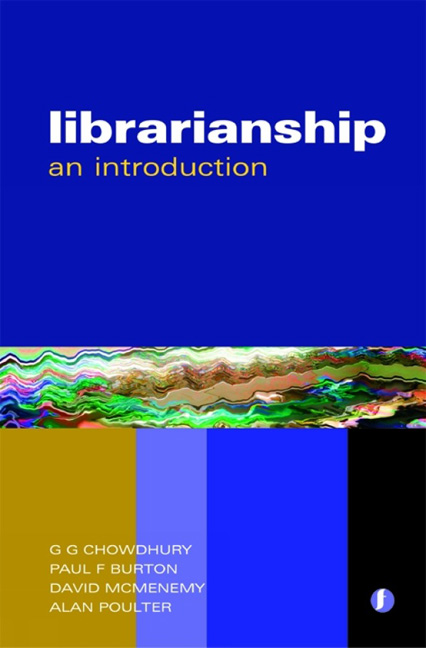Book contents
- Frontmatter
- Contents
- Preface
- Acknowledgements
- 1 Introduction
- Part 1 Libraries and information services: evolution or revolution?
- Part 2 Library and information resources and services
- Part 3 Information organization and access
- Part 4 Library and information users and society
- Part 5 Library technologies
- Part 6 Management and marketing in libraries
- Part 7 Education and research in librarianship
- Epilogue
- Glossary
- Resource list
- Index
Part 4 - Library and information users and society
Published online by Cambridge University Press: 08 June 2018
- Frontmatter
- Contents
- Preface
- Acknowledgements
- 1 Introduction
- Part 1 Libraries and information services: evolution or revolution?
- Part 2 Library and information resources and services
- Part 3 Information organization and access
- Part 4 Library and information users and society
- Part 5 Library technologies
- Part 6 Management and marketing in libraries
- Part 7 Education and research in librarianship
- Epilogue
- Glossary
- Resource list
- Index
Summary
This part consists of chapters on the library as a social institution, services to library users, and government legislation and policies. It describes the principal professional and ethical issues with which the librarian is faced in providing contemporary library and information services. The technical and social developments of the past few decades have heightened the need to be aware of more traditional challenges such as the protection of intellectual property (copyright) but they have also given rise to newer concerns, including data protection and privacy and freedom of information. Moreover, the widespread use of digital information resources has led to questions about the (continuing) role of the library and the librarian. Early in the development of the internet and the web, the idea arose that libraries and librarians would become unnecessary: eventually all the information we would ever need would be available in digital form to anyone with the necessary technology, while search engines would let us find whatever we sought.
As the web grew in the number and nature of the resources it provided access to, and as more and more people began to use it (for a great variety of purposes), these claims began to appear less and less realistic. Finding what one wanted among the vast number of web pages became increasingly difficult: finding accurate information became even more difficult, because it was possible to publish on the web without any of the intermediary processes of peer review, refereeing, having to demonstrate a demand and so on. As with all technologies, the web is thus a double-edged sword:
1 It provides an outlet for those whose views might otherwise be censored or blocked for some reason.
2 It provides an outlet for minority views and ideas which might never find a large audience (for example, ethnic and cultural minorities).
3 It provides an outlet for minority interests, hobbies, etc.
4 It provides worldwide access to the latest research as well as to unique materials.
5 It can therefore be the greatest single medium for freedom of speech we have yet known.
However, it can also:
6 provide an outlet for views which many might consider abhorrent or offensive (e.g., racism, pornography), the publication of which in one jurisdiction would not otherwise be possible
- Type
- Chapter
- Information
- LibrarianshipAn introduction, pp. 141 - 144Publisher: FacetPrint publication year: 2007

